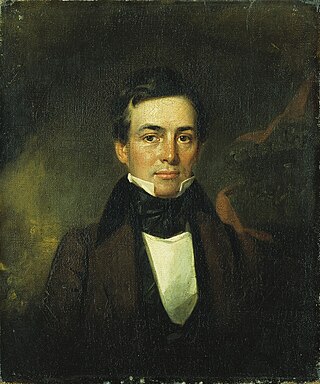
Thomas Chipman McRae was an American attorney and politician from Arkansas. He served as a Democratic member of the United States House of Representatives and the 26th Governor of Arkansas, from 1921 to 1925.

The 1851 Pennsylvania gubernatorial election occurred on October 14, 1851. Incumbent governor William F. Johnston, a Whig, was a candidate for re-election but was narrowly defeated by Democratic candidate William Bigler.

Townsend E. Gidley was an American politician who served eight terms in the Michigan Legislature and was instrumental in the drafting of the state's first constitution.

The 1835 Michigan gubernatorial election was held on October 5, 1835. Democrat nominee Stevens T. Mason defeated Whig nominee John Biddle with 91.22% of the vote. This was the first election in which Michigan voted in their Governor as a state.

The 1839 Michigan gubernatorial election was held from November 4, 1839 to November 5, 1839. Whig nominee William Woodbridge defeated Democrat nominee Elon Farnsworth with 51.64% of the vote.

The 1852 Michigan gubernatorial election was held on November 2, 1852. Incumbent Democrat Robert McClelland defeated Whig nominee Zachariah Chandler with 51.07% of the vote.

The 1853 Connecticut gubernatorial election was held on April 4, 1853. Incumbent governor and Democratic Party nominee Thomas H. Seymour defeated former state legislator and Whig nominee Henry Dutton and former state legislator and Free Soil nominee Francis Gillette with 51.01% of the vote.

The 1851 Connecticut gubernatorial election was held on April 7, 1851. It was a rematch of the 1850 Connecticut gubernatorial election. Incumbent governor and Democratic Party nominee Thomas H. Seymour defeated former state legislator and Whig nominee Lafayette S. Foster with 48.94% of the vote.

The 1851 Vermont gubernatorial election was held on September 2, 1851. The state continued its support for the Whig party, and Whig Governor Charles K. Williams was easily re-elected to a one-year term. The strong showing of the Free Soil Party candidate Timothy P. Redfield also showed that Vermont was on its way to becoming an anti-slavery bastion. The Democratic nominee, John S. Robinson went on to win the governorship in 1853.

The 1851–52 Massachusetts gubernatorial election consisted of an initial popular vote held on November 10, 1851, followed by a legislative vote conducted on January 12, 1852. Incumbent Democrat Governor George S. Boutwell was reelected to a second term in office. The ultimate task of electing the governor had been placed before the Massachusetts General Court because no candidate received the majority of the vote required for a candidate to be elected through the popular election.

The 1850–51 Massachusetts gubernatorial election consisted of an initial popular held on November 11, 1850 that was followed by a legislative vote that was conducted on January 11, 1851. It saw the election of Democratic Party nominee George S. Boutwell. The ultimate task of electing the governor had been placed before the Massachusetts General Court because no candidate received the majority of the vote required for a candidate to be elected through the popular election.

The 1851 Georgia gubernatorial election was held on October 6, 1851, to elect the governor of Georgia. Howell Cobb, nominee for the newly formed Constitutional Union Party, defeated the Southern Rights Candidate, Charles McDonald.

The 1849 Rhode Island gubernatorial election was held on April 4, 1849.

The 1853 Ohio gubernatorial election was held on October 11, 1853.

The 1836 Ohio gubernatorial election was held on October 11, 1836.

The 1839 New Hampshire gubernatorial election was held on March 12, 1839.

The 1842 New Hampshire gubernatorial election was held on March 8, 1842.

The 1839 Vermont gubernatorial election was held on September 3, 1839. Incumbent Whig Governor Silas H. Jennison defeated Democratic nominee Nathan Smilie with 52.48% of the vote.

The 1841 Vermont gubernatorial election was held on September 7, 1841.

The 1842 Vermont gubernatorial election was held on September 6, 1842.






















